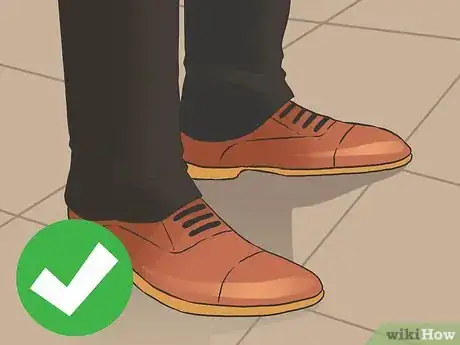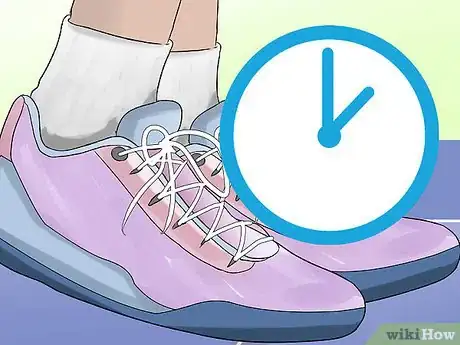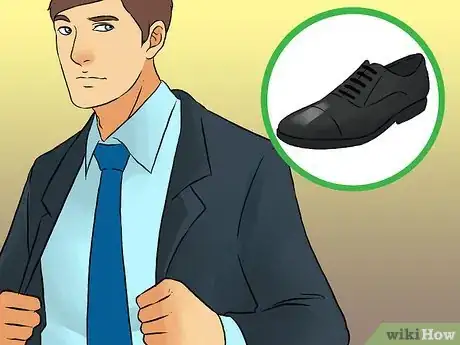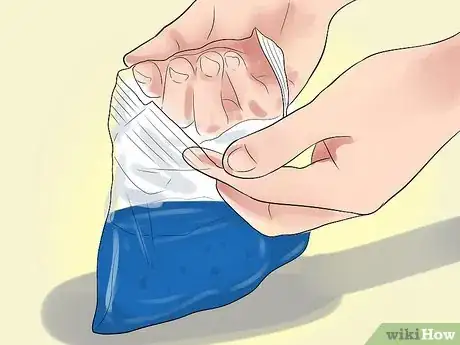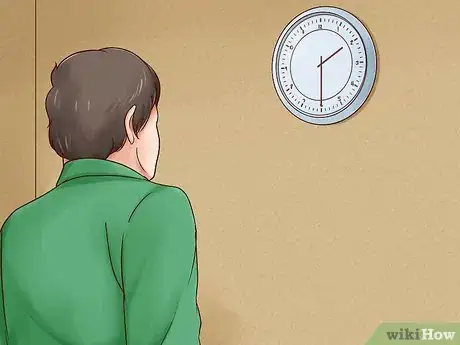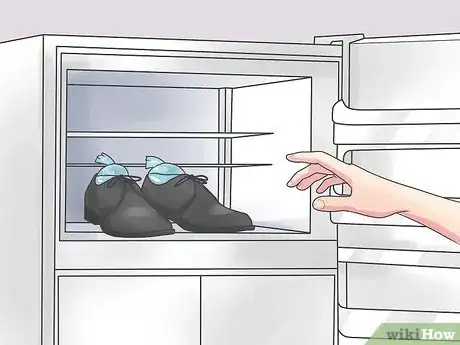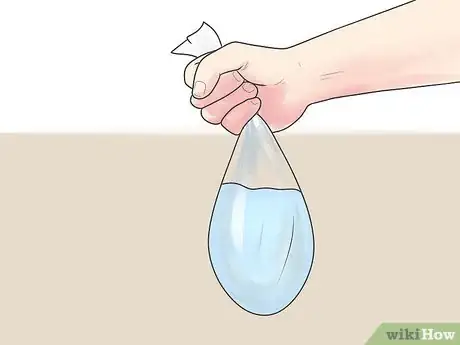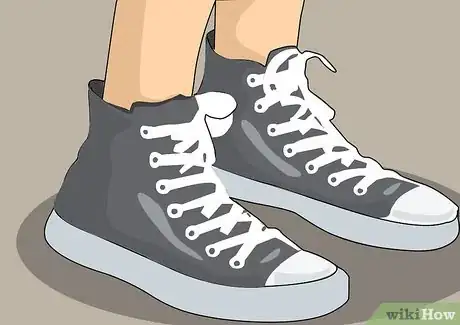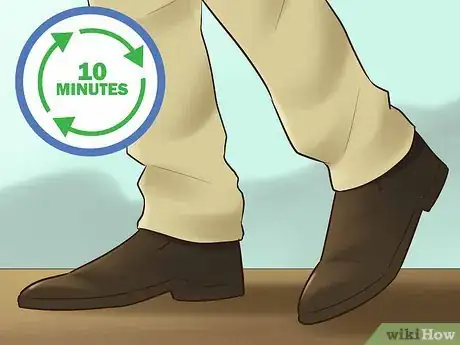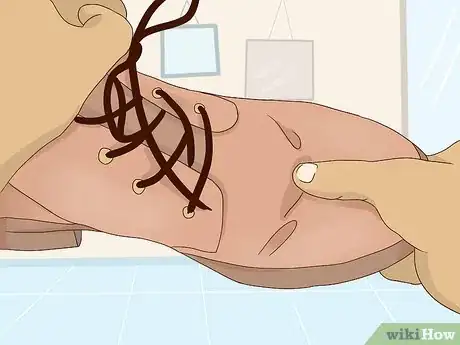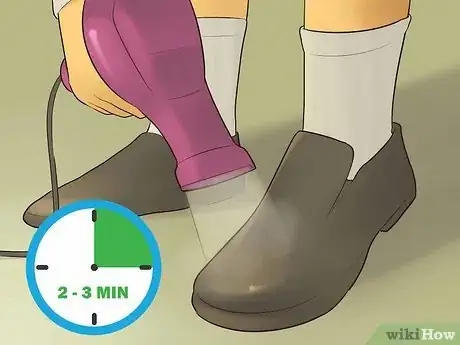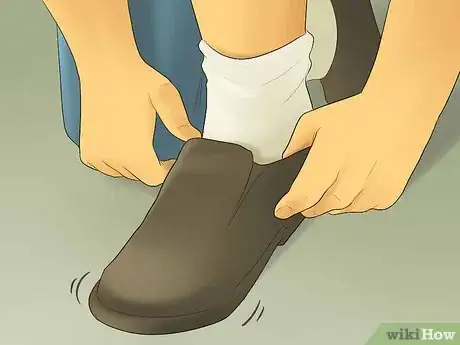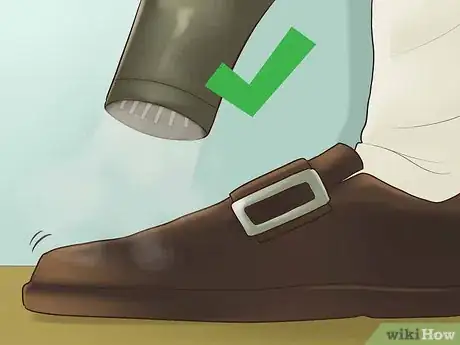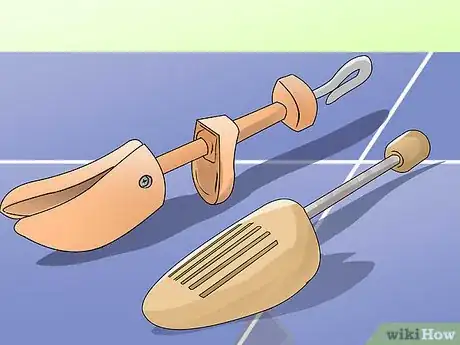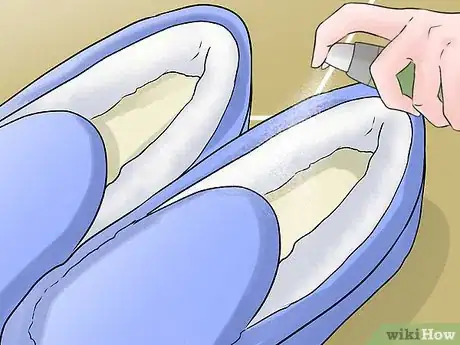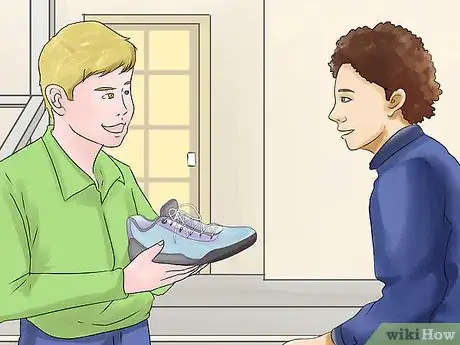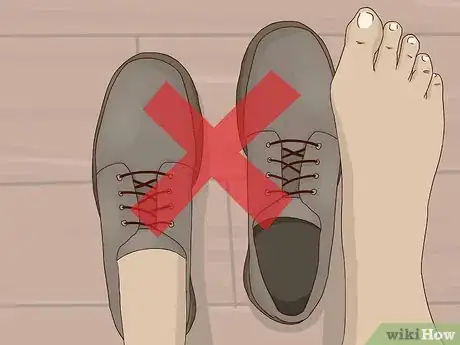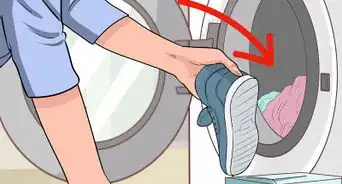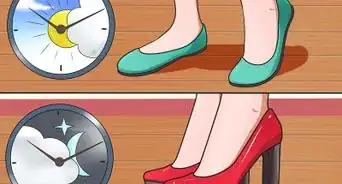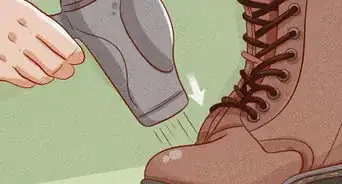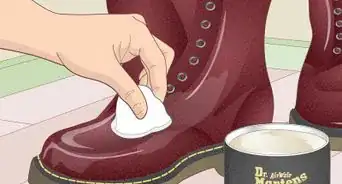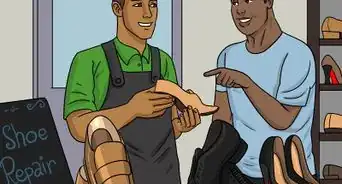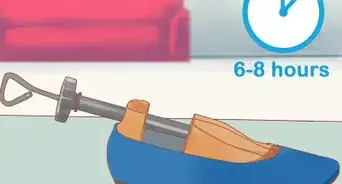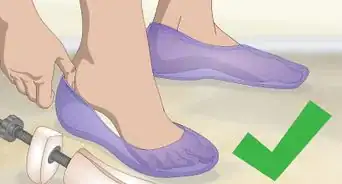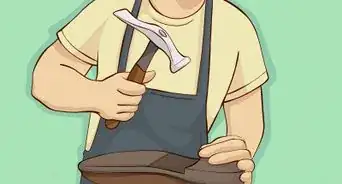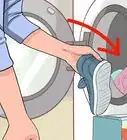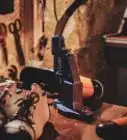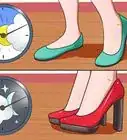This article was co-authored by Carroll Kelly. Carroll Kelly is a Shoe Care Specialist and the Owner of Austin Shoe Hospital in Austin, Texas. With over 37 years of experience, Carroll specializes in sustainable shoes, boots, belts, handbags, and luggage repair. Carroll graduated with a Bachelor’s degree from the University of Texas. Austin Shoe Hospital is a family-run business that started over 105 years ago from a single horse-drawn carriage. Today they are the largest and most recognized shoe repair company in the world.
This article has been viewed 1,066,380 times.
Have you ever bought a new pair of shoes only to find that they kill your feet? Well, don't take them back. They can be fixed simply by breaking them in. You're not really breaking them, but you're getting them used to your |feet. Here are some tips that should help you mold the new shoe to fit your feet.
Steps
Wearing Around the House
-
1Wear your new shoes around the house. Before you go out in them, try walking up stairs, standing around (cooking dinner, playing with kids, etc.), sitting down, and even running.[1]
- This is the most trusted method for easily and lightly breaking in your new shoes. If you have nice leather or dress shoes — shoes that you would be frustrated to see scuffed, altered, or even discolored — this method is the safest to try.
-
2Wear your shoes little and often at first. When you try out new shoes before you've bought them, you rarely walk away with sore feet, right? That's because you haven't donned your shoes for long enough to cause any pain (or alter the frame of the shoe to fit your foot). So, when breaking shoes in at home, wear early, wear often, and don't feel like you need to put your shoes on for hours at a time to notice a difference.[2]
- In fact, start with wearing your shoes 10 minutes at a time in the beginning. Try this for a couple days. Gradually, wear your shoes for 10 minutes more, every couple of days, until you're wearing the shoes for an hour at a time. By this time, the shoes should be tamed!
Advertisement -
3Bring your shoes to work. Wear some old shoes to work, but when you're sitting at your desk, bust out your new ones and simply get in the habit of having them on your feet. This is a simple way to break in your new shoes while saving time.
-
4Wear them with socks. This way, you can tell if you need socks when you wear them. This can also prevent blistering when getting used to new shoes.
- Wear your shoes with socks that are a little bigger than you normally would use. Try thick cotton socks, and squeeze into the shoes. Don't do any heavy walking, or you'll give yourself blisters. Just keep your feet in the shoe. The size of the sock will help stretch out the frame.
Freezing Shoes
-
1Fill up two sandwich bags halfway full of water. Make sure the bags are big enough so that they'll put pressure on the shoe when they expand in the freezer.[3]
- When you seal the plastic bag up, remove any air from the inside of the bag. This will make it easier to mold the water inside the bag to the contour of your shoe.
- This method will involve placing your shoes in the freezer for an extended period of time, during which time they may get wet. Be sure that the shoes you are using with this method aren't irreplaceable or susceptible to water damage.
-
2Place one of the baggies in each shoe. Make sure that the seal is tightly locked. You don't want your shoes covered in ice when you remove them from the freezer.[4]
-
3Put the shoes in a bigger, sealed plastic bag and place into freezer. Your shoes should contain a smaller plastic bag inside the cavity and a larger one protecting it from outside moisture.[5]
-
4Wait 3 to 4 hours. When the water inside the shoe freezes, it expands, putting pressure on the cavity in the shoe and breaking them in. The advantage of using water as opposed to a shoe stretcher is that the water will adjust to the contours of the inside of your shoe perfectly.
-
5Take the shoes out of the freezer. The water filled baggies should now be solid ice.
-
6Take the baggies out of your shoe. You may have to wait a few minutes in order to slide them out easier.
-
7Try on your shoes. Once the shoes have warmed up a bit, try walking in them and even running and jogging in them if they are athletic shoes.
Heating Shoes Up
-
1Wear the shoes for 10 minutes. Get the shoes on your feet, preferably with socks, and walk around for no more than 10 minutes. This is just to get them prepped.[6]
-
2Take the shoes off and stretch manually. If the shoe permits, bend it upwards and downwards a few times.
-
3Blast the shoe with heat. Heating the shoe will expand the material, especially if it's leather, making it more supple.
- Use a hair drier, turned to a hot (but maybe not hottest) setting, and heat the shoe up for 2 to 3 minutes.
- If you don't have a hair drier, try placing your shoes next to an indoor heater, or even directly out in the sun. Some heat is better than no heat.
-
4Immediately after heating, wear the shoes. Wear them around for another 10 minutes, walking, sitting, or even running.
-
5Repeat at least one more time. Your shoes will be tangibly more comfortable after a couple heat treatments.
Other Methods
-
1If possible, buy a shoe stretcher. These can help your shoes get a little less tight. If you don't want to buy a stretcher (though they can be cheap online), taking the shoe by the heel and the tip and flexing it back and forth works just fine.
- Make sure you wear your shoes after using the flex method or your shoes will lose their shape!
-
2Use a potato. Peel a large potato and leech some of the moisture off with a paper towel. Place the potato inside the cavity of the shoe and leave overnight. Remove in the morning.
- Make sure the potato is slightly bigger than the opening of the shoe, but not so big that it warps the toe box out of shape. You may need to carefully remove a portion of the potato so that it follows the shape of the shoe while still giving the material a little stretch.[7]
-
3Purchase some stretching spray. Spray the shoes with some stretching solution, following instructions on the packaging. Most of the time, instructions will recommend that you manually stretch the shoe back and forth in between sprays.
-
4Get a cobbler to machine-stretch shoes for you. Americans spend nearly $2 million on shoe stretching per year. A cobbler will spray the shoe with a stretching solution and then stretch the shoe over a machine for a couple hours while it dries. This shouldn't cost more than $20.
-
5Avoid these gimmicks. Some shoe-stretching techniques plain don't work or are bad for your shoes, especially nice leather ones. Avoid the following breaking-in techniques:
- Applying rubbing alcohol on your shoes. Alcohol can leave unsightly marks on nice leather shoes, as well as rob the leather of its natural oils.[8]
- Hitting the shoes with a hammer or another hard object. Hammering the backs of shoes could work, but at what cost? Is it worth it to have broken-in shoes that are actually broken?
- Having someone with bigger feet break your shoes in. Having someone with bigger feet break your shoes in is immoral and ineffective. Not only are you placing the burden of pain on another person (poor, poor person!), you're also letting the shoes conform to his or her feet, not your own! Avoid.
Expert Q&A
-
QuestionHow can I break in a pair of leather shoes?
 Carroll KellyCarroll Kelly is a Shoe Care Specialist and the Owner of Austin Shoe Hospital in Austin, Texas. With over 37 years of experience, Carroll specializes in sustainable shoes, boots, belts, handbags, and luggage repair. Carroll graduated with a Bachelor’s degree from the University of Texas. Austin Shoe Hospital is a family-run business that started over 105 years ago from a single horse-drawn carriage. Today they are the largest and most recognized shoe repair company in the world.
Carroll KellyCarroll Kelly is a Shoe Care Specialist and the Owner of Austin Shoe Hospital in Austin, Texas. With over 37 years of experience, Carroll specializes in sustainable shoes, boots, belts, handbags, and luggage repair. Carroll graduated with a Bachelor’s degree from the University of Texas. Austin Shoe Hospital is a family-run business that started over 105 years ago from a single horse-drawn carriage. Today they are the largest and most recognized shoe repair company in the world.
Shoe Care Specialist Bring them to a shoe repair shop. These shops have a specially formulated shoe stretch solution that won't discolor or stain the leather. While the leather is still wet, a professional will put a wooden shoe stretcher in the shoe to fix the tight spot.
Bring them to a shoe repair shop. These shops have a specially formulated shoe stretch solution that won't discolor or stain the leather. While the leather is still wet, a professional will put a wooden shoe stretcher in the shoe to fix the tight spot. -
QuestionWhy do I have to walk in them for ten minutes before heating them up with the blow dryer?
 Community AnswerIt helps to stretch out the material and begin forming it to your feet before it's heated.
Community AnswerIt helps to stretch out the material and begin forming it to your feet before it's heated. -
QuestionWhat can I do if my shoes are hurting the backs of my feet?
 Community AnswerIf your shoes are rubbing around the heel, then you may want to invest in some gel pads to place inside your shoes. In the meantime, I recommend putting band-aids on the part where the shoe is rubbing.
Community AnswerIf your shoes are rubbing around the heel, then you may want to invest in some gel pads to place inside your shoes. In the meantime, I recommend putting band-aids on the part where the shoe is rubbing.
Warnings
- These methods may prevent you from being able to return your shoes if needed.⧼thumbs_response⧽
- Water can damage some shoes. Read the label first!⧼thumbs_response⧽
References
- ↑ http://shoegazing.se/english/2017/06/08/the-tip-break-in-new-shoes-carefully/
- ↑ https://www.travelandleisure.com/style/shoes/how-to-break-in-shoes
- ↑ https://verilymag.com/2016/06/how-to-break-in-shoes-blisters-new-shoes
- ↑ https://gearpatrol.com/2016/05/12/break-climbing-shoes-without-pain/
- ↑ https://gearpatrol.com/2016/05/12/break-climbing-shoes-without-pain/
- ↑ https://verilymag.com/2016/06/how-to-break-in-shoes-blisters-new-shoes
- ↑ https://www.healthline.com/health/shoes-too-tight#stretch-them-out
- ↑ https://www.fibrenew.com/blog/frequently-recommended-leather-remedies-that-ruin-leather/
About This Article
To break in a new pair of shoes, wear them for 10 minutes before you take them off and bend them up and down to stretch them. Then, use a hair dryer to heat your shoes for 2-3 minutes, which will expand the material. Right after you heat your shoes, wear them for another 10 minutes so they’ll retain the size and shape of your feet as they cool. Alternately, you can use the natural expansion of water as it freezes to break in your shoes. Just fill sealable plastic bags with water, put them in your shoes, and put your shoes in the freezer for 3-4 hours before you wear them. To learn how to use a potato to break in a new pair of shoes, scroll down!
